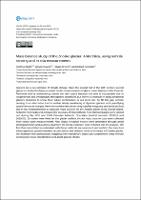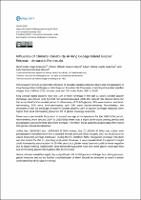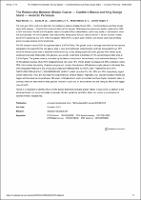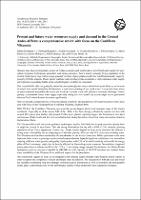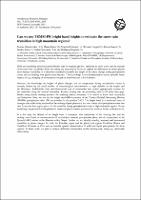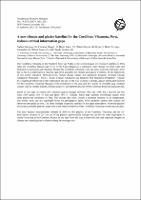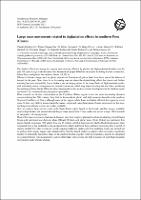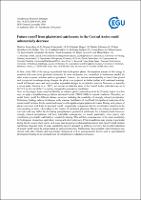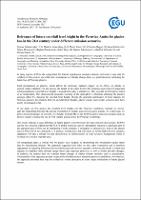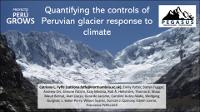Buscar
Mass balance study of the Znosko glacier, Antarctica, using remote sensing and in situ measurements
(European Geosciences Union, 2021-03)
Glaciers are a key indicator of climate change. Since the second half of the 20th century several glaciers in Antarctica have retreated. In situ measurements of glacier mass balance in the Antarctic Peninsula and its ...
Acceso abierto
Influence of Climate Variability in King George Island Glacier Retreat – Antarctic Peninsula
(European Geosciences Union, 2021)
This research aims to explain the influence of climatic variables (temperature and precipitation) in King George Island (KGI) glacier shrinkage on the Antarctic Peninsula. It employed Landsat satellite images from 1989 to ...
Acceso abierto
The Relationship Between Shallap Glacier - Cordillera Blanca and King George Island - Antarctic Peninsula
(American Geophysical Union, 2021-12)
The main goal of this study is to determine the relationship between Shallap Glacier (SG) — Cordillera Blanca and King George Island (KGI) glaciers — Antarctic Peninsula and describe their features. Multi-temporal analysis ...
Acceso abierto
Present and future water resources supply and demand in the Central Andes of Peru: a comprehensive review with focus on the Cordillera Vilcanota
(American Geophysical Union, 2014)
Glaciers have been an important element of Andean societies and livelihoods as direct freshwater supply for agriculture irrigation, hydropower generation and mining activities. Peru’s mainly remotely living population in ...
Acceso abierto
Can we use TRMM-PR bright band heights to estimate the snow-rain transition in high mountain regions?
(American Geophysical Union, 2015)
Field and modelling based research indicates that for tropical glaciers, variations in snow cover and the altitude of the snow line via albedo effects are among the most crucial factors to explain the differences in annual ...
Acceso abierto
A new climate and glacier baseline for the Cordillera Vilcanota, Peru, reduces critical information gaps
(American Geophysical Union, 2013)
The Cordillera Vilcanota in the Southern Peruvian Andes is the second largest ice-covered Cordillera in Peru (after the Cordillera Blanca) and serves for the Cusco Region as a temporary water storage for fresh-water and ...
Acceso abierto
Large mass movements related to deglaciation effects in southern Peru (Cusco)
(American Geophysical Union, 2013)
The Andes of Peru are among the regions most severely affected by glacier and high-mountain hazards over the past 100 years. Large-scale disasters with thousands of people killed are on record, including ice/rock avalanches, ...
Acceso abierto
Future runoff from glacierized catchments in the Central Andes could substantially decrease
(American Geophysical Union, 2016-04)
In Peru, about 50% of the energy is produced from hydropower plants. An important amount of this energy is produced with water from glaciated catchments. In these catchments river streamflow is furthermore needed for other ...
Acceso abierto
Relevance of future snowfall level height in the Peruvian Andes for glacier loss in the 21st century under different emission scenarios
(American Geophysical Union, 2017)
In many regions of Peru, the competition for limited hydrological resources already represents a large risk for conflicts. In this context, and within the circumstances of climate change, there is a great interest in ...
Acceso abierto
Quantifying the controls of Peruvian glacier response to climate
(American Geophysical Union, 2021-04)
Peruvian glaciers are important contributors to dry season runoff for agriculture and hydropower, but they are at risk of disappearing due to climate warming. Their energy balance and ablation characteristics have previously ...
Acceso abierto







